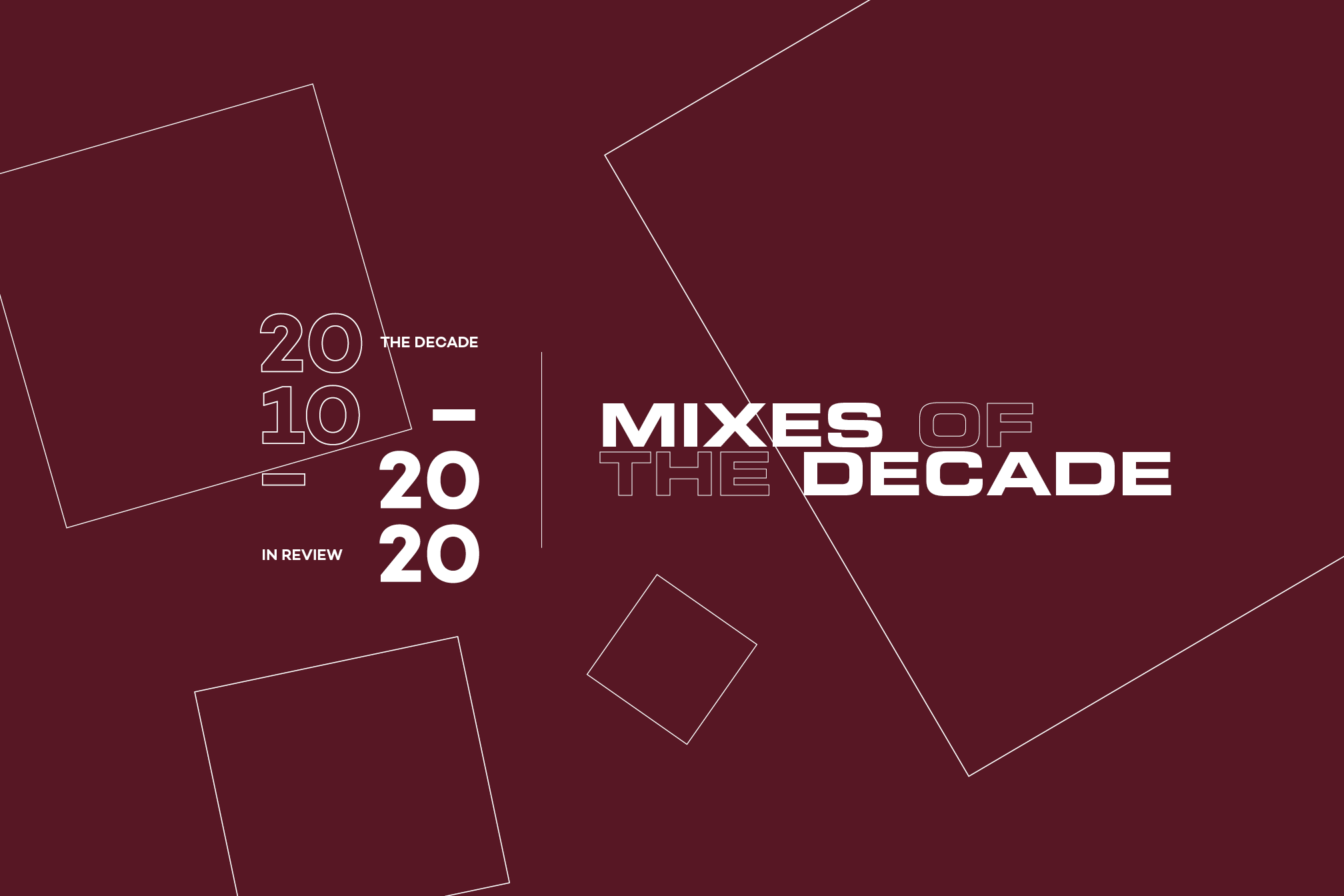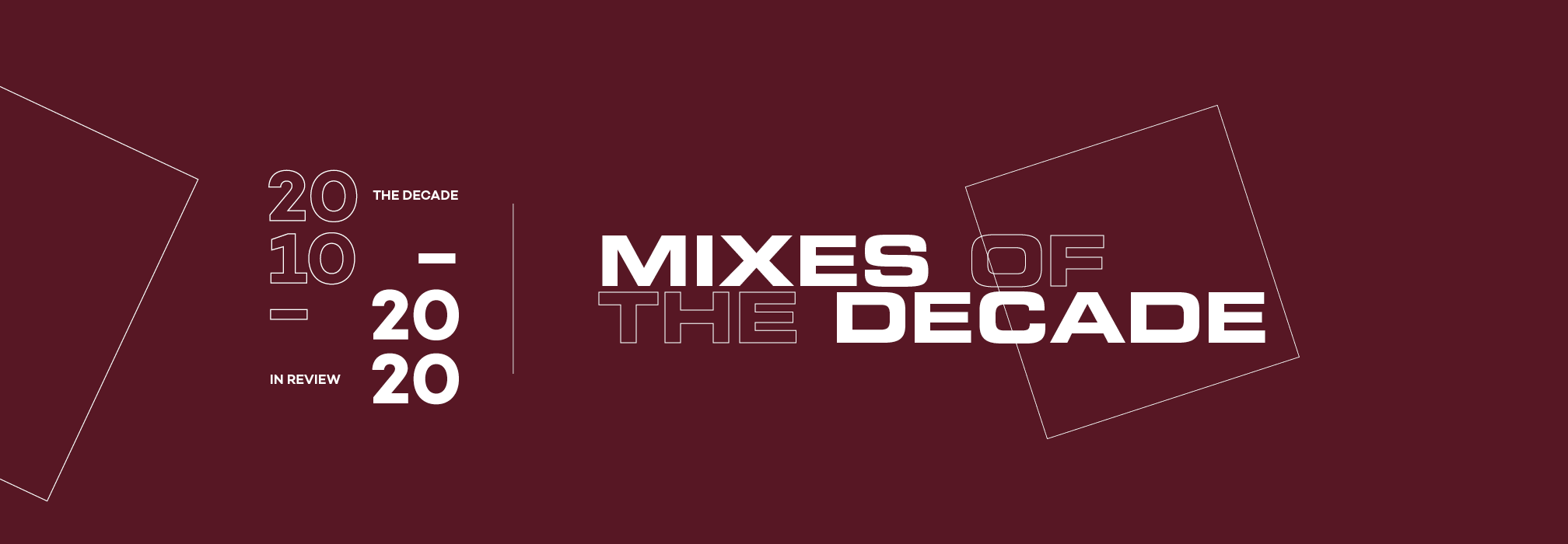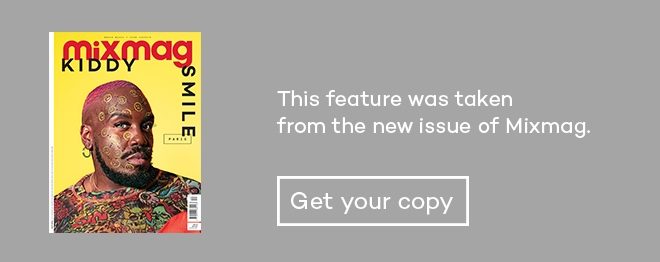 Features
Features
The 20 best DJ mixes of the decade 2010-2019
Mixes that shaped the decade
First things first: These sets, which range from one minute to six hours, are intended as a musical overview of the 2010s, a survey of key moments, movements and trends. We’ve learned this decade that DJ culture is far more various than we can know, but we tried to cast our net wide; in interest of fairness, I also left out anything I’ve already written about in the magazine. Here, then, are ten years in 30 hours—in chronological order, by earliest for group entries.
Read this next: 2018: The year in mixes
XLR8R Podcast 158 (August 2010) DJ Rashad & DJ Spinn
DJ Rashad and his partner DJ Spinn had spent years perfecting the footwork and juke styles for an intensely local Chicago scene when they went wide around the turn of the decade. Rashad’s sudden death in April 2014 was so unexpected it threw many fans for a loop—his widely praised solo album 'Double Cup' was released a mere six months before his passing. Since then, he’s become this decade’s equivalent of J. Dilla, his knotty constructs revealing new facets with every passing year. This set sums up that sound nicely—sub-heavy, the stuttering vocal samples especially eerie when laid over longer-lined ones (see Rashad’s “Ghost,” the third selection here), crisp, jangling percussion, and a radically decentered pulse.
FACT Mix 327 (April 2011) Disclosure
To my ears, no one merged club-adept beats and production with mainstream hook savvy during the 2010s like Disclosure did on their 2013 debut, 'Settle'. Yet there’s almost nothing pop about their set for FACT Magazine, not until their indestructible re-rub of Jessie Ware’s “Running” emerges seven minutes from the end, like a bonbon for dessert. Mostly, though, this is raw and rough and ready as UK garage gets, an iridescent groove skeleton that, after years of maximalist aesthetics, still plays with a tightly coiled power.
Boiler Room x RBMA London DJ Set (December 2012) DJ EZ
UK garage’s early-decade surge meant boom times for the style’s don, DJ EZ. Just kidding—he’s never stopped playing great sets from the 90s on. But his late-’12 Boiler Room appearance was a vital re-introduction to a new generation of London clubbers, from his brisk speed—while you went to the bathroom, EZ played five tunes—to quick-cut frippery that gave old-school tricks a new-tech gleam. In a decade dotted with titans making sets that redefined their legacies—see also Robert Hood at Weather Festival, Paris (June 2015), Greg Wilson at Big Chill (August 2010), andFrankie Knuckles at Boiler Room New York (April 2013)—EZ’s 45-minute romp was the most sheer fun.
FACT Mix 318 (February 2012) MikeQ
Jersey club arrives, in the figure of the East Orange, New Jersey producer and DJ whose remix, with B. Ames, of Zebra Katz feat. Njena Reddd Foxxx’s “I’ma Read” was inescapable in New York throughout 2012, not that anyone in her right mind wanted to escape it. That track’s success, and MikeQ’s sheer exuberant moxie on the decks, played a central role in disseminating the resurging ballroom style, created for voguing contests, full of snapping snares and de-emphasizing the straight (note term) four. This buoyant set (“I’ma Read” appears late) served notice of ballroom’s impending imminence; for updates, check Jasmine Infiniti’s Discwoman 03 (April 2016) and Divoli S’vere’s Crack Mix 259 (February 2019).
Read this next: A brief history of voguing
LWE Podcast 115 (March 2012) Ben UFO
A “20 Ben UFO mixes of the decade” list would not have been difficult to conjure. Hessle Audio, which he’d co-founded in 2007, was a key label in UK dubstep’s glorious late-’00s experimental phase, and as he started playing across the board, genre-wise, like a lot of his peers, he carried that try-anything sensibility into the 2010s. He’s the ultimate DJ’s DJ, seldom playing the same thing twice, consistently making connections across time and genre that seemed intuitive only after he’d done it. This set for the late, great Chicago dance site Little White Earbuds is pointillist, minimalist techno, with enough bass weight to shudder a boat, offering the eager, refined Ben UFO sensibility on a silver platter.

Essential Mix (April 2012) Rustie
It wasn’t just stadium EDM that went large during the decade’s first half. The “digital maximalism”—Simon Reynolds’ term—that Rustie flaunted on 2011’s 'Glass Swords' involved an engorged sound palette, cartoonishly bulbous, filled with squiggling details. His brilliantly kinetic edition of Essential Mix looked back to a Daft Punk-circa-'Discovery' sense of wonder and ahead to the plinky constructs of PC Music. Plus it was the world debut of Baauer’s “Harlem Shake,” one of the biggest pop accidents of the decade when a viral video drove it to number one in America a year later.
DJ-Kicks (Studio !K7 CD, April 2012) Maya Jane Coles
London house producer-DJ Maya Jane Coles seemed to arrive out of nowhere. She started releasing music in 2008, at age 20, but then her 12-inch 'What They Say' landed atop the Resident Advisor DJ chart for October 2010, and her career jetted from there—the first new female dance star of the new decade, with a slew more to follow. Coles has pursued a steadfast course—her albums have a clear artistic focus, and her kind of deep house fits both the phrase’s post-EDM profile (meaning bassy tech-house) and its original meaning of soulful and jazzy. But this mix is a definitive snapshot of her arrival, not to mention her expansive, sly, occasionally ethereal palette.
Ultra Main Stage, Miami (March 2013) Avicii
Ever hear the one about the guy who played a DJ set only for a live show to break out in the middle? Unveiling the material that would make up his blockbuster debut album, 'True', Avicii struck a blow from within against the EDM status quo/hegemony with this brave and controversial set, which showed how one of its leading stars had outgrown its strictures. In retrospect, he made every other artist in the genre look creatively stagnant—while also, paradoxically, opening the door for it, and them, to cross over into the pop mainstream, all with a side of banjo.
Read this next: Maximum Levels: Avicii turned electronic music into a global phenomenon
Epic Mashleg (June 2013) Daleri
A good DJ set can make a virtue of the idea that dance music “all sounds alike,” by showing how different similar things can be. And sometimes a set can turn that idea into a weapon. This parody mix with over a million plays to date—consisting of ‘drops’ from a contemporaneous Beatport sales list that sound an awful lot alike—not only effortlessly revealed the vapid bombast at the heart of “big room” production, but also arguably proved a small yet fatal wound that could not be staunched. EDM’s long fall begins here.
Essential Mix (June 2013) Skrillex
The Face of American Dubstep could have just thrown any old slop together for Pete Tong’s Friday-night slot and people would have hailed it as the second coming—his comet was that hot. Instead, Skrillex seized his moment brilliantly with this two-hour tour de force that didn’t just ease back on the bass-melt—there’s still plenty, of course—but also folded in a wide array of new and old underground tracks (Disclosure, Blawan, Josh Wink) to contextualize everything further. It’s a set of deep peaks and skyscraping valleys, crafted with real care—he was out to prove something, and did.

Beats In Space Radio Show #705, Pt. 2 (November 2013) Awesome Tapes From Africa
One of the stickiest, and most unfortunate, genre tags of the 2010s was the catchall “Afrobeats.” It was misleading two ways—by not being Afrobeat, the militant funk groove that Fela Kuti invented and perfected, and by presuming to speak for an entire continent. Hopefully, OkayAfrica’s editorial on the matter from February 2019 is the last word. (They’re against it.) Yet its adoption also demonstrated just how much more visible African dance music—old and new, electronic or not—has become in global DJ culture.
Brian Shimkovitz started Awesome Tapes From Africa in 2006 as a blog from his home in Brooklyn—uploading cassettes he’d picked up while studying musicology in Ghana, West Africa. Soon enough, Awesome Tapes was also the name of his reissue label and his moniker as a DJ—naturally, his sets are played entirely from cassettes. I saw him in late 2015, at Good Room in Brooklyn, where a group of African women danced in a circle—and as they swooped downward, a white guy to my right took out his phone and turned on the flashlight app so they could find what they seemed to be looking for on the floor. That, my friends, was Brooklyn in the 2010s. Awesome Tapes’ set for Tim Sweeney’s WNYU show Beats In Space is vigorously assured, and no wonder—it’s mostly tracks he’s reissued himself, of stuff that’s obscure even at home. The older episodes of BIS are subscription-only; this one is worth the splurge.
Subscribe and listen here.
Mixmag Live, Village Underground, London (July 2015) Black Coffee
From kwaito in the 90s forward, South Africa has long been a hotbed for homegrown house variations. But Black Coffee’s Mixmag Live set in 2015 didn’t just announce a new global superstar; it heralded South African house as a genuine force in club culture. “To South Africans it doesn’t matter what you play, DJing is a very open format,” fellow S.A. DJ-producer Themba said recently—but over these three hours from London, Black Coffee offers a deeply unified vision for the country’s club music, weaving American deep house into kickier South African tracks and keeping things at a boil the entire time.
Read this next: Africa Is Not A Jungle: How Black Coffee is leading a music industry revolution
FACT Mix 516 (October 2015) DJ Marfox
One key area of Afro-diasporic DJ activity was Lisbon, where DJ Marfox (Marlon Silva) who’d been at it since the mid-2000s, took until the middle of this decade to start getting booked regularly in the city’s centre. “My music was associated with poverty and crime,” he explained to Mixmag—Lisbon kuduro, the grime of the Portugal ghettos. His spare, sinuous, undulant grooves, which combine house and techno with Angolan kuduro, batida, and kizomba, are spare and instantly approachable—“the waist-windingest music I’ve ever heard,” averred critic Philip Sherburne—but also spiky and illuminated, like a glow necklace that emits volts.
RA.421 (June 2014) Lena Willikens
Düsseldorf’s Salon Des Amateurs was clearly one of the great, unique clubs of the ’10s, with an antic musical personality that its onetime resident Lena Willikens described as an “anarchy [that] was mirrored in the crowd. A totally diverse range of people felt attracted to come here, from a 60-year-old professor to an 18-year-old skater.” Willikens, in particular, plays with a deadpan no-walls psychedelic borderless kind of mischief that’s singular even in a decade full of DJ omnivores. From the keening organ of Khidja’s “Mustafa” to the Louis & Bebe Barron-go-underwater feel of Ekoplekz’s “Nerva Beacon,” they’re stitched together into an arc that genuinely seems to be transmitting live from Mars.
Final Night at Plastic People, London (January 2015) Floating Points & Four Tet
The shutting down of London clubland was one of the decade’s persistent black marks. fabric’s temporary closing provoked the loudest outcry, but it was hardly alone. When Shoreditch’s Plastic People, which had featured a stellar lineup of residencies (Josey Rebelle, Theo Parrish, Carl Craig, the crucial dubstep night FWD>>), had to bow out at the top of 2015, it did so right, with two of its best playing all night long. The set is both the summation of the mid-decade back-to-back boom and the ultimate example of the sort of post-digital crate-digging that Four Tet in particular specializes in, labels like Melodies International and Numero Group that specialize in off-canon stuff, a place a lot of DJs live now. Despite its inordinate length—six hours!—it’s been number one on the tracklist repository MixesDB’s “Hottest Mixes” listing since it came out, for good reason. It’s both DJs at their most generous and open. It’s not through-mixed by any means; if anything it’s intensely selected, and they’re on an effortless roll throughout—freewheeling, loose, magnanimous, not show-offy, always feeding the vibe.

The Bunker Podcast 099 (July 2015) The Black Madonna
It’s healthy to distrust your memory sometimes—especially when it comes to nightclubs. Since I was in attendance—at The Bunker’s Pride party, in the Panther Room, the second space at Brooklyn’s now-shuttered Output—I wonder occasionally if I overrate this one. Nope—it’s pandemonium beginning to end. Although it heralded another major DJ arrival, right as she was taking off, The Black Madonna had been around, selling mixtapes at raves from 1992 and later the booker for Chicago’s Smart Bar, one of the decade’s crucial spaces, helping launch the international careers of Eris Drew and Chrissy, among others. That entire timeline is lit up with positive pleasure here—especially when she drops Evelyn Thomas’s 1984 landmark “High Energy.”
Fabric 91 (Fabric CD, December 2016) Nina Kraviz
The fabric and FabricLive CD mix series came to a close at 100 volumes apiece in 2018, and while there are still physical copies of DJ sets afoot, most notably the oldest, 'DJ-Kicks', an era has clearly passed. One of the best late volumes belonged to one of the decade’s definitive figures. Nina Kraviz was the bellwether of a Russian “revolution” (I know, sorry) with encyclopedic knowledge—once at Brooklyn’s The Lot Radio she spun all Russian classical music—and an inclination toward deeply psychedelic tracks, many of which she released on her label трип (Trip), founded in 2014. Kraviz’s fabric set showcases that bendy Eastern European craziness, throwing in some 90s Midwestern warehouse techno (tracks 2 to 5) right as its vogue took off.
Read this next: The 10 best fabric mix CDs
Essential Mix (February 2017) Helena Hauff
It’s not a coincidence that we’ve gotten a bombardment of EBM/industrial-flavored techno lo these past few years, nor that it has often come from goth-as-fuck women. But Helena Hauff isn’t just a great modern DJ archetype, she’s a great DJ, period. Her re-emphasis of the Wax Trax! elements of house and the KMFDM aspects of techno help disguise that Hauff hardly just plays darkwave—there’s plenty of good, slithering electro and acid here too—but it’s all so deliciously menacing it might as well be. This was voted Essential Mix of the Year for good reason—it bounces like a basketball, and it’s a marker in time for a DJ who’s indelibly marked hers.
Mixmag: The Cover Mix (June 2018) Lotic
“Sonic experimentation” was rampant in 2010s dance music—I’ve had my skull peeled back at full-on EDM shows by consistently unpredictable sound design—so chin-stroking music did just fine. Deconstructed r'n'b was so commonplace in the experimental era—see the drastically pitched-down Jets tapes on James Ferraro’s FACT Mix 289 (March 2013)—that in the track guide to this Cover Mix, Lotic wrote of the opening track, “I know y’all tired of me doing Beyoncé edits, and I swear this is the last.” Since her Mixmag set seemed to explode in 15 directions at once, while stopping you in your tracks, she's forgiven. It’s also a wire-taut deconstructed club tribute to Black Panther, with vocal drop-ins from Beyoncé, Björk, Soulja Boy & Nicki Minaj while touching on seemingly every style under the sun.
Honey Dijon RA.657 (December 2018)
Another DJ lifer with a great many mixtapes to show for it, Honey Dijon grew up in Chicago, spent much of the 90s and early 2000s in San Francisco, and has been a Brooklynite for most of the past two decades. Her playing style has always been forthrightly celebratory, and her increasingly high profile, culminating in a triumphant 2018 and the launch of her own fashion line, paralleled the decade’s rise in trans visibility. This set, released last New Year’s Eve, flexes a moodier vibe than Dijon usually shows. But it’s every bit as intensely danceable—a look back at her underground roots that also moves in solidarity with a darker, more serious time for DJ culture and the world.
Michaelangelo Matos is the author of The Underground Is Massive, follow him on Twitter
Read this next: Get the best of Mixmag direct to your Facebook DMs





